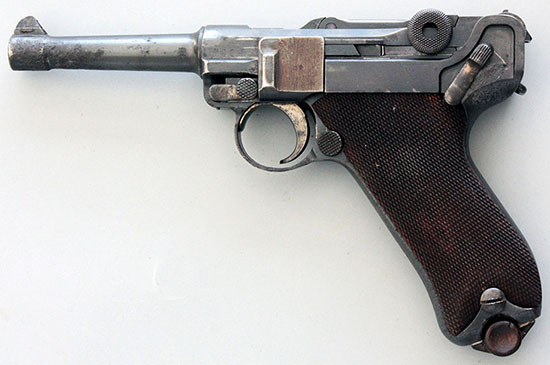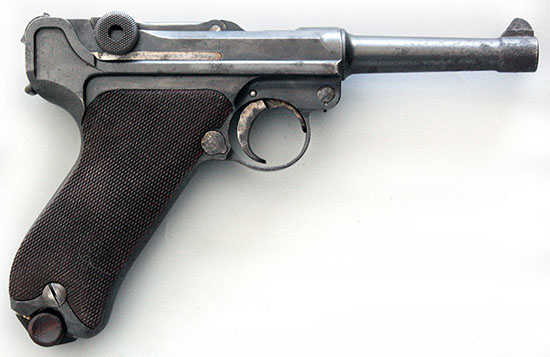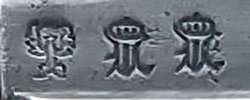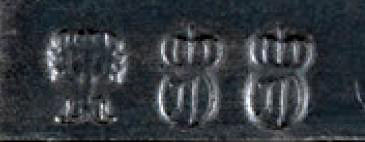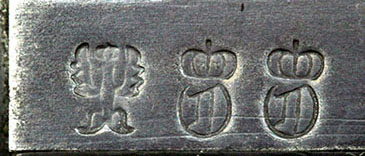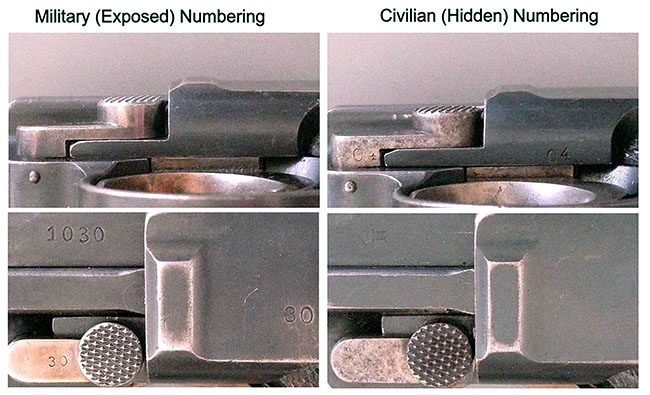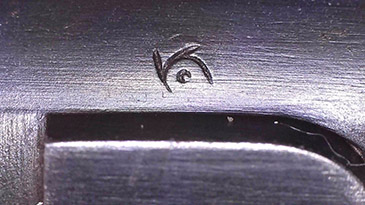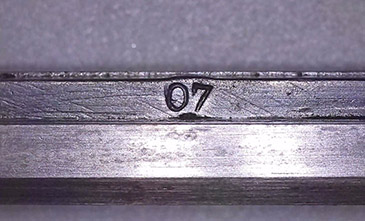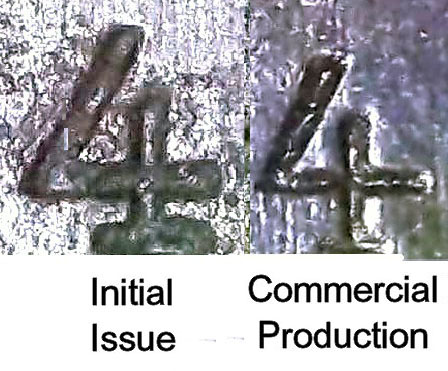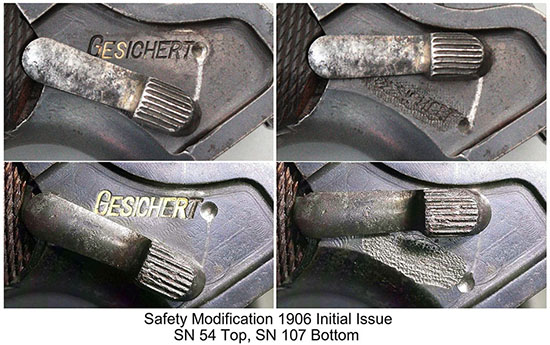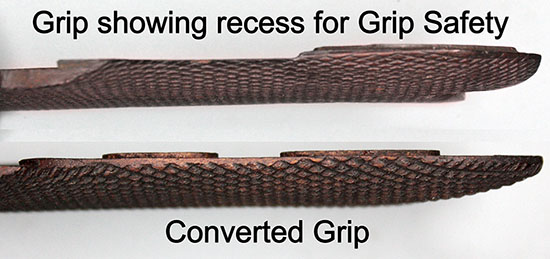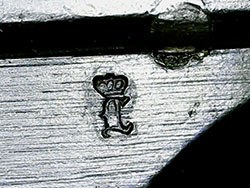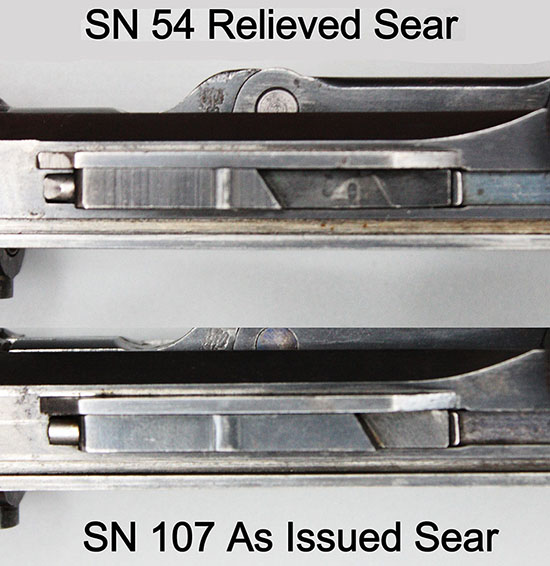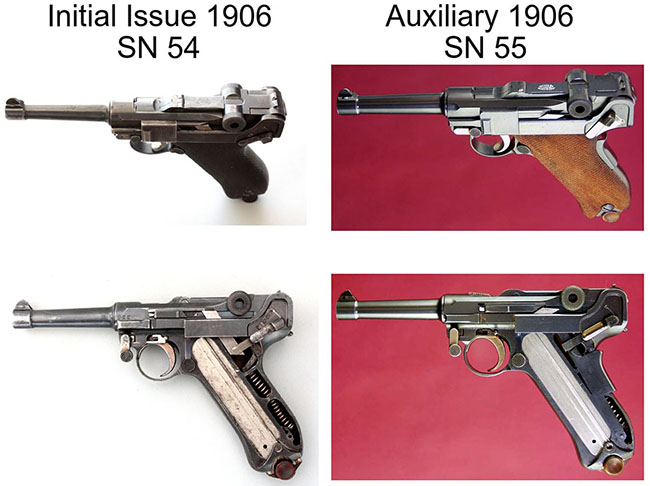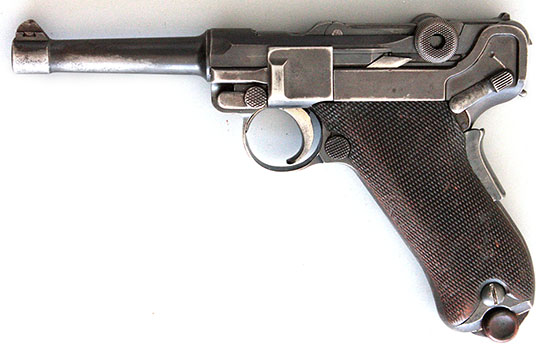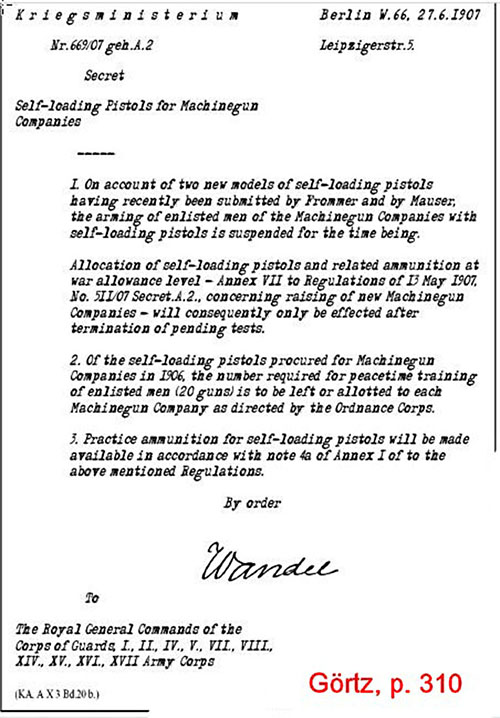 |
|||||||||||||||||||||||||||||||||||||||||||||||||||||||||||||||||||||||||||||||||||||||||||||||||||||||||||||||||||||||||||||||||||||||||||||||||||||||||||||||||||||||||||||||||||||||||||||||||||||||||||||||||||||||||||||||||||||||||||||||||||||||||||||||||||||||||||||||||||||||||||||||||||||||||||||||||||||||||||||||||||||||||||||||||||||||||||||||||||||||||||||||||||||||||||||||||||||||||||||||||||||||||||||||||||||||||||||||||||||||||||
|
1906 “Test” Lugers: A Reappraisal “1906 German Army Test ... A very rare Luger” —Jan Still 1. Introduction I was fortunate to recently find, and purchase, a 1906 “Test” Luger. When I first got it I did not realize the depth of the rabbit hole I had entered.
To begin, the Lugers that are the subject of this paper are not “Test” Lugers by any commonly accepted meaning of the term. A directive of June 27, 1907 (Appendix I) makes it clear that these weapons were, in fact, issued to active troops and were to be actually trained with. 0f the self-loading pistols procured for Machinegun Companies in 1906, the number required for peacetime training of enlisted men (20 guns) is to be left or allotted to each Machinegun Company as directed by the Ordnance Corps. (Görtz, 2010, p. 310) Walter (1995) observes: ...in March 1907, the army adopted the 9mm Luger for the four experimental infantry machine-gun detachments formed in August 1906. (p. 112) These were, as the documents show, the first Lugers officially issued to German Army troops. Görtz (2010) states this definitively: It should be noted that these were not further trials pistols ... but were procured as service weapons for regular issue... (p. 350) They were issued to “experimental” Machine Gun Companies, a fact that might have suggested some sort of “testing” was going on, but this is not supported by the existing literature. As such, the word “Test” is inappropriate. I suggest that henceforward we use the term “1906 Initial Issue” when discussing these pistols. This accurately describes what they are: the first Lugers issued to German Army troops.
Before we discuss the details, let me suggest, in “cheat sheet” fashion, how one identifies a 1906 Initial Issue Luger. Note that these Lugers were for military use and would all have been chambered in 9mm. Key initial difference from P.06 Lugers
The foregoing characteristics are necessary and sufficient to identify an Initial Issue Luger. The standard issue P.06 Lugers would have a five digit serial number as well as a factory installed toggle hold open without an acceptance mark associated with it. And, naturally, being civilian, there would be no military proofs or other markings. P.06 Lugers might, though, be found in either 9mm or .30 caliber. There was a change to the original pistol which most likely occurred around the time of issuance, circa 1907:
Changes from the original pistol most likely occurring around 1913:
These characteristics will be discussed more fully.
There are seven references that I have been able to discover that refer to these weapons specifically (Appendix IV), of which six have only a short paragraph (or less) of discussion, and only three of which use the term “1906 Test Luger” (Still 1991 & 2007 and Noll 2020). Costanzo (1977) refers to “Trials” that occurred in 1906. However, these “Trials” concerned Frommer and Mauser pistols (Walter 1986, p. 131). I suspect that a misreading of Costanzo's statement was the reason that the 1906 Initial Issue Lugers came to be called “Test” Lugers.
Typically, when one embarks on research into a firearm (or virtually any other area of inquiry), one goes to the classic data sources. There, one expects a fair to high level of informational consistency. One might find a snippet of additional information, as one peruses the sources, but one does expect consistency. And if there should be found some odd piece of information, subsequent authors will acknowledge it, reconcile it with commonly accepted facts, or clearly refute it. Oh really? Silly boy. These are Lugers after all. I think that it is important here to underscore the paucity and unreliability of the data regarding these pistols. As far as I have been able to ascertain, there are 18 extant examples. Of these, we have photographs of eight. Data has been repeated and passed from one writer to the next with, I fear, little investigation and virtually no references or corroboration. A sampling of the thin literature is in order. I will reference Görtz repeatedly in this section inasmuch as he devotes far more discussion to these weapons than any other author. As I mentioned, there are seven references that refer to these weapons, of which six have only a short paragraph (or less) of discussion. Costanzo (1977), the earliest reference I have located, refers to 50 Lugers being “tested” (and failing) in 1906, he also cites an inspection mark that he is alone in reporting (see below). Görtz points out that Frommer and Mauser pistols were “tested” at this time and they both failed, thus securing adoption of the Luger. Could Costanzo have mistaken which pistols were tested? He is, however, quite specific in identifying two “Lugers” from this testing (numbers 3 & 48) that are in collectors hands today. Naturally, no photos are provided, nor have they appeared anywhere else to my knowledge. Walter (1986 & 1995) refers to the testing, also in 1906, of Mauser and Frommer designs, both of which failed. Again, this event may have been the one reported by and misinterpreted by Costanzo who was in turn almost certainly misinterpreted by Still: Walter (1986, page 131) reports that approximately 375 9mm caliber 1906 style Lugers were tested by experimental infantry machine gun detachments starting in 1907. (Still, 2004) Walter reports no such thing. He was referring to the testing of the Frommer and Mauser pistols. Though, later, Still (2007a) does seem to question Walter in a Forum post: Walter (page 131) reports three, sn 118, 171. and 193, which are described as retaining their grip safety. However he further states that they bear only a single acceptance stamp forward of the side plate (he may have these confused with the 1902 German Army Test). Walter, in both his references, refers to three “survivors” of this early deployment (serial numbers 118, 171 & 183) which all have: “a single military inspector's mark on the left side of receiver ahead of the trigger-plate.” I have been able to physically examine serial number 171. It has no marks whatsoever. This pistol was held up as one that was originally issued in 1907 as a “Test” Luger in four references between 1986 and 2007. It was not. A cursory examination of it would have confirmed this. Clearly the writers never saw it. And Walter's insistence on a “single” inspector’s mark on a “Test” Luger is inconsistent with other references and the few examples for which we have photographic evidence. Walter (1995) does, however, provide an illustration of an Old Model Luger used in early tests (Plate 4). This example is too early to be considered an Initial Issue but it does have one inspector's mark on the receiver ahead of the trigger plate. Perhaps this was the source of the confusion about inspector's marks. One might be forgiven for identifying Walter's examples as “questionable”; certainly one of them is (#171).
As one reviews the literature, one is rather struck by the variation in the reported number and form of acceptance marks. Görtz (2010, p. 309) states, rather authoritatively, that: They were stamped with two Spandau arsenal inspector’s marks (crown/O on early pistols, crown/E on serial numbers above approximately 100) and the Imperial Eagle pressure proof marks... Yet Costanzo provides an illustration of marks purportedly on two examples (Serials 3 & 48, p. 248):
And another example that has avoided the scrutiny of the aforementioned authors also has a distinct mark resembling the one in Costanzo (serial 16):
As you can see, the references provide a bit of a challenge. From them there does not appear to be a definitive method of identifying these weapons, hence our “Cheat Sheet”, above. Appendix II contains the data on examples that have either been referenced in the literature or personally examined by the author. There are eighteen examples of 1906 Initial Issue Lugers and three examples that meet many of the criteria for such an identification but lack Military acceptance marks. Of the eighteen, eleven have Regimental markings, one has later Police markings. None of the remainder have been examined by me, so we do not know whether they were issued and/or marked. Neither do we know whether all examples were modified to P.08 specifications. We know the military acceptance marks for only ten of the 18 examples. And, if that were not enough, two of the examples (from Walter 1986 & 1995) and the two cited by Costanzo (1977) may have been misidentified, thus reducing the known samples to thirteen. I make more use of weasel words such as “it appears” or “it seems that” and so on than I am comfortable with but, until our knowledge base expands, that is the best one can do. If ever we needed a clear demonstration of T.E. Lawrence's dictum, this pistol provides it: A series of exceptions to some undiscoverable rule... The German Army “tested” Lugers over a fairly long period. By 1906 it seems that the decision to employ this weapon had been made (though not formalized at the highest level) and a contract was made with DWM to provide some number of Luger pistols to the Army, specifically to certain Machine Gun Regiments (Appendix III). The number of pistols provided has been variously reported, though the number 220 seems to be popular, and the serial numbers were in a series separate from other Luger production, supposedly extending from 1 to about 220. These were drawn from production of New Model Lugers with coil mainsprings, which began their serials at 25xxx. I will come back to the serialization question anon but note that the 220 number might extend to 350 or even higher.
These pistols were standard M. 1906 Commercial Lugers in 9mm, with minor exceptions. They had 4” barrels, grip safeties, short frames, commercial numbering and other characteristics appropriate to this model. They were not equipped with a toggle hold open, per Military requirements, though production commercial models produced at the same time did have that feature. They also did not have a stock lug. The word “Gesichert” (Safe) was present in the LOWER safety position. That is to say SAFE = UP. The commercial versions had the finish under the safety lever in the lower position polished bright (i.e., “in the white”). It is thought that the “Gesichert” engraving was because the receivers were left over from the recent production of Navy Lugers, but this is speculation. They also had the internal marks characteristic of the early issue New Model commercial pistols, including the Catherine wheel stamp on the ring next to the barrel stop, as well as a one digit number stamped on the other side of the stop. The last two digits of the serial are on the bottom of the sear and the stop lug and there is a flaming bomb stamp in the well that accommodates the side plate release. A purported Initial Issue MUST show:
Note that three reported examples have different acceptances. Serial 16 shows:
This particular example appears to be an intact 1906 (with grip safety). Serials 3 and 48 reported by Costanzo purportedly have this mark:
And other characteristics consistent with routine production of P.06 Lugers.
While it is assumed that the original configuration of this pistol was a New Model P. 06, two examples that have come down to us retain the grip safety and all the others reflect the changes associated with that conversion (Görtz p. 309). These changes are identified below. So, as issued, 1906 Initial Issue Luger's were, essentially, early production 1906 Luger's without a hold open and with military acceptance stamps on the left side of the receiver and with low serial numbers (i.e., less than, say, 350). Only two examples have come down to us that retain the 1906 grip safety, all the others reflect the changes associated with the modifications to conform to P.08 specifications (Görtz p. 309). These changes are discussed below. Interestingly, the serials on the frame and barrel are relatively large in size: 2.8mm.
At some point the forward grip strap was engraved with a regimental identification, whether this was universal for all issued pistols is unknown.
At some other point, presumably in 1913 or thereabouts, when Lugers were recalled to have a toggle hold open installed, some number of these pistols were converted to P.08 configuration. That is to say, the grip safety was removed and the safety lever was converted to “SAFE = DOWN”. The word Gesichert was engraved in the upper position and the original word in the lower position was obliterated (which is the correct word) by application of a punch, repeatedly. The left grip was replaced with one that had no recess for the absent grip safety.
The picture below shows a comparison of an original grip from a Grip Safety equipped Luger (Top) with a modified grip.
It is unknown how many Initial Issue pistols were so converted. Lack of conversion is not, therefore, indicative of anything. There is one confirmed example that was not converted (# 16). Converted pistols are apt to have a toggle hold open installed. If it was installed due to the military order, you will find a small acceptance mark on the right side of the receiver.
It is worthwhile to examine SN 54. This Initial Issue had the usual modifications (hold open installed, replacement of the grip safety) but in addition, there are acceptance marks on the trigger and take down lever which might indicate a repair. Further, it has a relieved sear which is only seen on one other example (SN 117) which had also been accepted into Police service.
The Regimental mark has been obliterated as can be seen in the photo comparing it to an intact marking. We can be reasonably sure that the mark was excised because of the remaining “Dot” which signified the ends of fields in the description. This mark is often rather deep and might have been thought to impact the structural integrity of the piece if removed. We are fortunate in having photos of SN 55 which is an Auxiliary piece not modified in any way from it's commercial brothers except for the serial. A close examination of the photos (the gun itself was not available) confirms that the two weapons are identical except for the modifications described above.
The fact that two pistols have adjacent serial numbers but are differently configured makes one scratch ones head. What was the process for choosing one versus another pistol for Army use? The choice must have occurred prior to installation of a hold open. In a practical world, how was it that these two pistols were sequentially numbered? It seems that the numbering (or perhaps the assignment of a number) had to have occurred when one was chosen for service and the other, disconsolately, left behind. Perhaps as more of these Auxiliary types are reported upon, we will see some light shed on this issue. For further discussion of the issuance and modifications to these weapons, the reader is referred to Görtz (2010, p. 311-318). When issued, these pistols were doubtless model 1906 commercial pistols and it was only when the final design of the Luger for Army service was finalized that they were modified to P.08 specifications.
On a related topic, it appears that DWM produced some number of pistols to the same specifications as those produced for the Machine Gun companies which were not acceptance marked or proofed, though serialized in the “Initial Issue Luger” manner, i.e., with large three digit numbers. Görtz suggests that the serial numbers are above the (supposed 220) upper limit for the issued Lugers. He also states that the toggle hold open was factory installed at the time of manufacture so no inspector’s mark is associated with it. These were commercial Lugers in every way except for the odd serial numbers. Serial 171, as reported by Walter (1986 & 1995) and Still (1991 & 2007) as a “Test” Luger is not a “Test” but, rather, one of these “Auxiliary” Lugers.
At present there are three examples of this type of pistol: serials 55, 171 and 229. They are identified in the database as Aux(iliary). The basic tell for this (sub)variation is that there are no Military stamps on the receiver, and the guns have three digit serial numbers. The toggle hold open was installed at the time of manufacture so there is no inspection stamp. The existence of serials 55 and 171 is interesting from a number of standpoints. Perhaps the most significant is that they fall into the sequence of hitherto reported authentic Initial Issue Lugers, which suggests that issuance of the so-called Test Lugers did not occur in an uninterrupted block of serial numbers. This discussion was triggered by a footnote in Görtz (p. 352-353): The directive from the War Ministry of 27 June 1907 stated that the scale of issue of these pistols would be 20 per Machine Gun Company for peace time training purposes. This directive was sent to the HQ’s of the Gardekorps and 10 other Armeekorps who had participated in the formation of the then experimental Machine Gun Companies; the serial numbers of these pistols run up to around 220 however, which corresponds to 20 pistols per Korps, rather than 20 per Company, issue at this scale to all 16 Companies listed above implying a requirement for some 320 pistols, rather than the ~220 of the known serial number range: the reasons for this discrepancy are lost in time. The documented issuance of these pistols was 20 per Machine Gun Company. The highest serial in our database is 276 which exceeds the implied highest serial number (220) one would expect if 20 pistols were issued to each of the 10 Army Corps. If 20 were issued (as documented) to each Machine Gun Company, that would imply around 320 pistols in total. But none above 276 are currently reflected in our database. As Görtz states: the reasons for this discrepancy are lost in time (p.353) Or, perhaps, DWM produced some number of pistols beyond the ones that have the Army acceptance marks. To quote Görtz on different pistols: ... DWM produced pistols in excess of the numbers needed, as mechanically identical examples of both exist in the same serial number ranges with higher numbers in the 859x and 995x – 6x ranges, with and without grip-safety respectively, but without the crown/D acceptance marks types.) (p. 86) Perhaps we know of some of them. Perhaps they are the “Auxiliary” Lugers discussed above. Görtz describes the Manual on these (true) First Issue Lugers in some detail. In it (in 1907, remember) are described two types of safety: the safety was described as either “a) ...pistol with automatic safety and applied safety” or simply as “b)...pistol with applied safety” (p. 350) He goes on to state: the duality of the manual in this regard, however, indicates that both types were in simultaneous use during 1907. Both types must therefore have been in service at the time of issue of the manual in June 1907, and yet the P.08 was not adopted officially until August 1908, nor was the first batch of 50,000 ordered from DWM until November 1908. This manual therefore raises the question of what exact precursor version of the P.08 without grip safety was in service with the M.G. units in 1907 along with the known militarily accepted New Model pistols. (p. 351) One might bravely suggest that there is an actual date for the modifications to the Initial Issue Lugers, and that it is immediately prior to issuance, thus making them pistols with only an “applied safety”. One might also suggest that the “Auxiliary” Lugers were issued along side of them. They, or the examples we have seen, have both the “applied safety” and the “automatic safety”. A Bold Claim. Perhaps one day we will know. Order Concerning Distribution of 1906 Initial Issue Lugers
Data Base
Machine Gun Regiments Who Received 1906 Test Lugers
I had no idea when I started writing this that it would be so fraught with dead ends and annoying inconsistencies. In any event, I would like to thank Ed Buffaloe for his encouragement and learned advice and editorial guidance. Thanks to Will Schmitz of NewMexicoFirearms@Yahoo.com for selling me both (!) Lugers that got me started down this particular rabbit hole. And thanks to Brandon Metcalf, Gentleman and Scholar, who provided much needed information. I should note then when there are only three of something ALL information is needed. Finally, thanks to Phil A of the Still Gunboards for permission to quote him. |
|||||||||||||||||||||||||||||||||||||||||||||||||||||||||||||||||||||||||||||||||||||||||||||||||||||||||||||||||||||||||||||||||||||||||||||||||||||||||||||||||||||||||||||||||||||||||||||||||||||||||||||||||||||||||||||||||||||||||||||||||||||||||||||||||||||||||||||||||||||||||||||||||||||||||||||||||||||||||||||||||||||||||||||||||||||||||||||||||||||||||||||||||||||||||||||||||||||||||||||||||||||||||||||||||||||||||||||||||||||||||||
|
Copyright 2025 by Ed Dittus. All rights reserved. |
|||||||||||||||||||||||||||||||||||||||||||||||||||||||||||||||||||||||||||||||||||||||||||||||||||||||||||||||||||||||||||||||||||||||||||||||||||||||||||||||||||||||||||||||||||||||||||||||||||||||||||||||||||||||||||||||||||||||||||||||||||||||||||||||||||||||||||||||||||||||||||||||||||||||||||||||||||||||||||||||||||||||||||||||||||||||||||||||||||||||||||||||||||||||||||||||||||||||||||||||||||||||||||||||||||||||||||||||||||||||||||
|
|
|||||||||||||||||||||||||||||||||||||||||||||||||||||||||||||||||||||||||||||||||||||||||||||||||||||||||||||||||||||||||||||||||||||||||||||||||||||||||||||||||||||||||||||||||||||||||||||||||||||||||||||||||||||||||||||||||||||||||||||||||||||||||||||||||||||||||||||||||||||||||||||||||||||||||||||||||||||||||||||||||||||||||||||||||||||||||||||||||||||||||||||||||||||||||||||||||||||||||||||||||||||||||||||||||||||||||||||||||||||||||||
